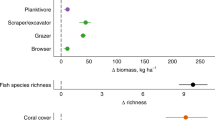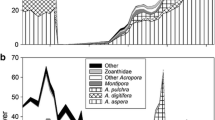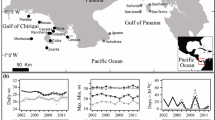Abstract
Coral reef communities exposed to rapid temperature rises and frequent thermal anomalies were evaluated for taxonomic turnover via presence/absence information over a 27-year period experiencing large changes in the dominant taxa. Temporal turnover of the taxa within sites was consistently high (~ 40%) due to both inter-annual episodic and directional changes. Turnover with time displayed a rapid increase and slow decline after sequential cool and warm thermal anomalies between 1996 and 1998. Subsequent warm temperature anomalies caused fewer broad-scale changes. Directional change for all sites combined indicated three overall gains and losses in taxa—Montipora being the only dominant taxon that declined in both abundance and presence/absence. The studied marine reserves had higher local but lower between-site taxonomic richness than fished reefs. Despite similar mean turnover, there were fewer gains than losses in marine reserves (7 gains and 20 losses in 5 sites) than fished sites (16 gains and 15 losses in 7 sites). Changes in taxonomic cover and presence/absence turnover data were not correlated, indicating that turnover detects finer scale taxonomic change likely to be missed when the cover of the dominant taxa is evaluated—especially in the higher richness marine reserves. High spatial richness, community change, and thermal acclimation in these shallow reef lagoons may have prevented higher net losses of taxa. Consequently, the probabilities of reducing local extirpations of taxa may be best achieved by planning and management that promotes spreading more evenly-spread access restrictions to reef areas with high between-site diversity rather than focusing restrictions to sites with high within-site diversity.







Similar content being viewed by others
References
Allen KA, Bruno JF, Chong F, Clancy D, McClanahan TR, Spencer M, Żychaluk K (2017) Among-site variability in the stochastic dynamics of East African coral reefs. PeerJ 5:e3290
Ateweberhan M, McClanahan TR (2016) Partitioning scleractinian coral diversity across reef sites and regions in the Western Indian Ocean. Ecosphere 7:e01243
Baird AH, Marshall PA (2002) Mortality, growth and reproduction in scleractinian corals following bleaching on the Great Barrier Reef. Marine Ecology Progress Series 237:133–141
Baselga A (2010) Partitioning the turnover and nestedness components of beta diversity. Global Ecology and Biogeography 19:134–143
Baselga A, Orme D, Villeger S, Bortoli JD, Leprieur F (2018) betapart: partitioning beta diversity into turnover and nestedness components. R package version 1.5.1. https://CRAN.R-project.org/package=betapart
Bellwood DR, Hughes TP, Folke C, Nystrom M (2004) Confronting the coral reef crisis. Nature 429:827–832
Bruno JF, Côté IM, Toth LT (2019) Climate change, coral loss, and the curious Case of the parrotfish paradigm: Why don’t marine protected areas improve reef resilience? Annual Review of Marine Science 11:307–334
Carpenter KE, Abrar M, Aeby G, Aronson RB, Banks S, Bruckner AW, Chiribora A, Cortes J, Charles Delbeek J, DeVantier L, Edgar GJ, Edwards AJ, Fenner D, Guzman HM, Hoeksema BW, Hodgson G, Johan O, Licuanan WY, Livingstone SR, Lovell ER, Moore JA, Obura DO, Ochavillo D, Polidoro BA, Precht WF, Quibilan MC, Reboton C, Richards ZT, Rogers AD, Sanciangco J, Sheppard A, Sheppard C, Smith J, Stuart S, Turak E, Veron JEN, Wallace CC, Weil E, Wood E (2008) One-third of reef-building corals face elevated extinction risk from climate change and local impacts. Science 321:560–563
Carreiro-Silva M, McClanahan T (2012) Macrobioerosion of dead branching Porites, 4 and 6 years after coral mass mortality. Marine Ecology Progress Series 458:103–122
Ceccarelli DM, Emslie MJ, Richards ZT (2016) Post-disturbance stability of fish assemblages measured at coarse taxonomic resolution masks change at finer scales. PLoS One 11:e0156232
Côté IM, Darling ES (2010) Rethinking ecosystem resilience in the face of climate change. PLoS Biology 8:e1000438
Daskalova GN, Myers-Smith IH, Bjorkman AD, Blowes SA, Supp SR, Magurran AE, Dornelas M (2020) Landscape-scale forest loss as a catalyst of population and biodiversity change. Science 368:1341–1347
Darling ES, Alvarez-Filip L, Oliver TA, McClanahan TR, Côté IM (2012) Evaluating life-history strategies of reef corals from species traits. Ecology Letters 15:1378–1386
Darling ES, McClanahan TR, Côté IM (2013) Life histories predict coral community disassembly under multiple stressors. Global Change Biology 19:1930–1940
Darling ES, McClanahan TR, Maina J, Gurney GG, Graham NAJ, Januchowski-Hartley F, Cinner JE, Mora C, Hicks CC, Maire E, Puotinen M, Skirving WJ, Adjeroud M, Ahmadia G, Arthur R, Bauman AG, Beger M, Berumen ML, Bigot L, Bouwmeester J, Brenier A, Bridge TCL, Brown E, Campbell SJ, Cannon S, Cauvin B, Chen CA, Claudet J, Denis V, Donner S, Nur Fadli E, Feary DA, Fenner D, Fox H, Franklin EC, Friedlander A, Gilmour J, Goiran C, Guest J, Hobbs J-PA, Hoey AS, Houk P, Johnson S, Jupiter SD, Kayal M, Kuo C, Lamb J, Lee MAC, Low J, Muthiga N, Muttaqin E, Nand Y, Nash KL, Nedlic O, Pandolfi JM, Pardede S, Patankar V, Penin L, Ribas-Deulofeu L, Richards Z, Edward Roberts T, Rodgers KS, Mohd Safuan CD, Sala E, Shedrawi G, Min Sin T, Smallhorn-West P, Smith JE, Sommer B, Steinberg PD, Sutthacheep M, James Tan CH, Williams GJ, Wilson S, Yeemin T, Bruno JF, Fortin M-J, Krkosek M, Mouillot D (2019) Social-environmental drivers inform strategic management of coral reefs in the Anthropocene. Nature Ecology and Evolution https://doi.org/10.1038/s41559-019-0953-8
Deser C, Phillips AS, Alexander MA (2010) Twentieth century tropical sea surface temperature trends revisited. Geophysical Research Letters. https://doi.org/10.1029/2010GL043321
Donner SD, Carilli J (2019) Resilience of Central Pacific reefs subject to frequent heat stress and human disturbance. Scientific Reports 9:1–13
Dowle M, Srinivasan A (2019) data.table: Extension of ‘data.frame’. R package version 1.12.2. https://CRAN.R-project.org/package=data.table
Edmunds PJ, Adjeroud M, Baskett ML, Baums IB, Budd AF, Carpenter RC, Fabina NS, Fan T, Franklin EC, Gross K, Han X, Jacobson L, Klaus JS, McClanahan TR, O’Leary JK, van Oppen MJ, Pochon X, Putnam HM, Smith TB, Stat M, Sweatman H, van Woesik R, Gates RD (2014) Persistence and change in community composition of reef corals through present, past, and future climates. PLoS One 9:e107525
Gilmour JP, Smith LD, Heyward AJ, Baird AH, Pratchett MS (2013) Recovery of an isolated coral reef system following severe disturbance. Science 340:69–71
Graham NAJ, Nash KL, Kool JT (2011) Coral reef recovery dynamics in a changing world. Coral Reefs 30:283–294
Hallett L, Avolio M, Carroll I, Jones S, MacDonald A, Flynn D, Slaughter P, Ripplinger J, Collins S, Gries C, Jones M (2019). _codyn: Community Dynamics Metrics. https://doi.org/10.5063/f1n877z6. R package version 2.0.3. https://github.com/NCEAS/codyn
Højsgaard S, Halekoh U (2020) doBy: Groupwise Statistics, LSmeans, Linear Contrasts, Utilities. R package version 4.6.5. https://CRAN.R-project.org/package=doBy
Hooper DU, Chapin FS, Ewel JJ, Hector A, Inchausti P, Lavorel S, Lawton JH, Lodge DM, Loreau M, Naeem S, Schmid B (2005) Effects of biodiversity on ecosystem functioning: A consensus of current knowledge. Ecological Monographs 75:3–35
Hughes TP, Anderson KD, Connolly SR, Heron SF, Kerry JT, Lough JM, Baird AH, Baum JK, Berumen ML, Bridge TC, Claar DC (2018) Spatial and temporal patterns of mass bleaching of corals in the Anthropocene. Science 359:80–83
Hughes TP, Barnes ML, Bellwood DR, Cinner JE, Cumming GS, Jackson JB, Kleypas J, Van De Leemput IA, Lough JM, Morrison TH, Palumbi SR (2017) Coral reefs in the Anthropocene. Nature 546:82–90
LaJeunesse TC, Bhagooli R, Hidaka M, DeVantier L, Done T, Schmidt GW, Fitt WK, Hoegh-Guldberg O (2004) Closely related Symbiodinium spp. differ in relative dominance in coral reef host communities across environmental, latitudinal and biogeographic gradients. Marine Ecology-Progress Series 284:147–161
Lemmens JWTJ (1993) Reef-building corals (Cnidaria: Scleractinia) from the Watamu marine national reserve, Kenya; An annotated species list. Zoologische Mededelingen 67:453–465
MacKenzie DI (2005) What are the issues with presence–absence data for wildlife managers? The Journal of Wildlife Management 69:849–860
Maturi E, Harris A, Mittaz J, Sapper J, Wick G, Zhu X, Dash P, Koner P (2017) A new high-resolution sea surface temperature blended analysis. Bulletin of the American Meteorological Society 98:1015–1026
McClanahan TR (1988) Seasonality in East Africa’s coastal waters. Marine Ecology Progress Series 44:191–199
McClanahan TR (2014) Decadal coral community reassembly on an African fringing reef. Coral Reefs 33:939–950
McClanahan TR (2017) Changes in coral sensitivity to thermal anomalies. Marine Ecology Progress Series 570:71–85
McClanahan TR, Ateweberhan M, Graham NAJ, Wilson SK, Sebastián CR, Guillaume MM, Bruggemann JH (2007) Western Indian Ocean coral communities: Bleaching responses and susceptibility to extinction. Marine Ecology Progress Series 337:1–13
McClanahan TR, Azali MK (2020) Improving sustainable yield estimates for tropical reef fisheries. Fish & Fisheries. https://doi.org/10.1111/faf.12454
McClanahan TR, Darling ES, Maina JM, Muthiga NA, D’agata S, Arthur R, Jupiter S, Wilson SK, M. S, Leblonde J, Muttaqin E, Pardede S, Nand Y, Ussi AM, Humphries AT, Patankar VJ, Guillaume MMM, Keith SA, Shedrawi G, Pagu J, Grimsditch G (2019) Temperature patterns and mechanisms influencing coral bleaching during the 2016 El Niño. Nature Climate Change. https://doi.org/10.1038/s41558-019-0576-8
McClanahan TR, Graham NAJ, Darling ES (2014) Coral reefs in a crystal ball: Predicting the future from the vulnerability of corals and reef fishes to multiple stressors. Current Opinion in Environmental Sustainability 7:59–64
McClanahan TR, McLaughlin SM, Davy JE, Wilson WH, Peters CE, Price KL, Maina J (2004) Observations of a new source of coral mortality along the Kenyan coast. Hydrobiologia 530:469–479
McClanahan TR, Mutere JC (1994) Coral and sea urchin assemblage structure and interrelationships in Kenyan reef lagoons. Hydrobiologia 286:109–124
McClanahan TR, Muthiga NA, Mangi S (2001) Coral and algal changes after the 1998 coral bleaching: Interaction with reef management and herbivores on Kenyan reefs. Coral Reefs 19:380–391
Mellin C, Aaron MacNeil M, Cheal AJ, Emslie MJ, Julian Caley M (2016) Marine protected areas increase resilience among coral reef communities. Ecology Letters 19:629–637
Mellin C, Bradshaw CJA, Fordham DA, Caley MJ (2014) Strong but opposing β-diversity–stability relationships in coral reef fish communities. Proceedings of the Royal Society of London B: Biological Sciences 281:e20131993
Oksanen J, Blanchet FG, Friendly M, Kindt R, Legendre P, McGlinn D, Peter R, Minchin PR, O’Hara RB, Simpson GL, Solymos P, Stevens MHH, Szoecs E, Wagner H (2019) vegan: Community Ecology Package. R package version 2.5-5. https://CRAN.R-project.org/package=vegan
O’Leary JK, Potts DC, Braga JC, McClanahan TR (2012) Indirect consequences of fishing: Reduction of coralline algae suppresses juvenile coral abundance. Coral Reefs 31:547–559
Perry CT, Alvarez-Filip L, Graham NA, Mumby PJ, Wilson SK, Kench PS, Manzello DP, Morgan KM, Slangen AB, Thomson DP, Januchowski-Hartley F (2018) Loss of coral reef growth capacity to track future increases in sea level. Nature 558:396–400
Price NN, Martz TR, Brainard RE, Smith JE (2012) Diel variability in seawater pH relates to calcification and benthic community structure on coral reefs. PLoS One 7:e43843
Rahel FJ (1990) The hierarchical nature of community persistence: A problem of scale. The American Naturalist 136:328–344
Sall J, Lehmaan A, Creighton L (2001) JMP start statistics. A guide to statistics and data analysis, 2nd edn. Duxbury Press, Pacific Grove, California
Selig ER, Bruno JF (2010) A global analysis of the effectiveness of marine protected areas in preventing coral loss. PLoS One 5:e9278
Selig ER, Casey KS, Bruno JF (2012) Temperature-driven coral decline: The role of marine protected areas. Global Change Biology 18:1561–1570
Thibaut LM, Connolly SR (2013) Understanding diversity–stability relationships: Towards A unified model of portfolio effects. Ecology Letters 16:140–150
Torda G, Donelson JM, Aranda M, Barshis DJ, Bay L, Berumen ML, Bourne DG, Cantin N, Foret S, Matz M (2017) Rapid adaptive responses to climate change in corals. Nature Climate Change 7:627
Van Woesik R, Irikawa A, Anzai R, Nakamura T (2012) Effects of coral colony morphologies on mass transfer and susceptibility to thermal stress. Coral Reefs 31:633–639
Wickham H (2016) ggplot2: Elegant Graphics for Data Analysis. Springer-Verlag, New York
Zinke J, Gilmour JP, Fisher R, Puotinen M, Maina J, Darling E, Stat M, Richards ZT, McClanahan TR, Beger M, Moore C (2018) Gradients of disturbance and environmental conditions shape coral community structure for south-eastern Indian Ocean reefs. Diversity and Distributions 24:605–620
Acknowledgements
This work was supported by the Wildlife Conservation Society and supported by a number of organizations, including the Pew Charitable Trust, Tiffany & Co. Foundation, and the Western Indian Ocean Marine Science for Management Program. Clearance to do research in Kenya was provided by Kenya’s Office of Science and Technology and in the parks by Kenya Wildlife Services. Many people assisted with the monitoring notably R. Arthur, M. Azali, E. Darling, C. Hicks, A. T. Kamukuru, R. Kiambo, J. Kosgei, B. Kaunda-Arara, J.Kawaka, R. Machaku, H. Machano Ali, S. Mangi, J. Maina, J.Mariara, R. Moothien-Pillay, J. Mutere, N. A. Muthiga, S. Mwacheriya, J. Ndagala, R. Odenya, J. Omukoto, and M. J. Rodrigues. J. Kosgei assisted with producing figures and tables.
Author information
Authors and Affiliations
Corresponding author
Ethics declarations
Conflict of interest
The authors declare that they have no conflict of interest.
Additional information
Topic Editor Morgan S. Pratchett
Publisher's Note
Springer Nature remains neutral with regard to jurisdictional claims in published maps and institutional affiliations.
Rights and permissions
About this article
Cite this article
McClanahan, T.R. Decadal turnover of thermally stressed coral taxa support a risk-spreading approach to marine reserve design. Coral Reefs 39, 1549–1563 (2020). https://doi.org/10.1007/s00338-020-01984-w
Received:
Accepted:
Published:
Issue Date:
DOI: https://doi.org/10.1007/s00338-020-01984-w




